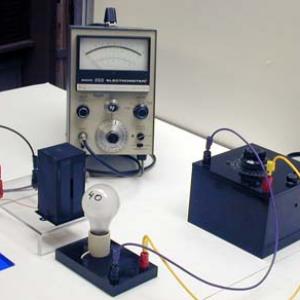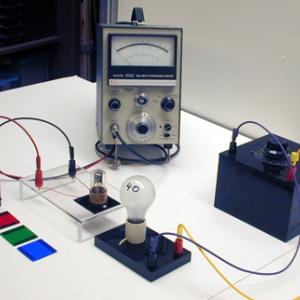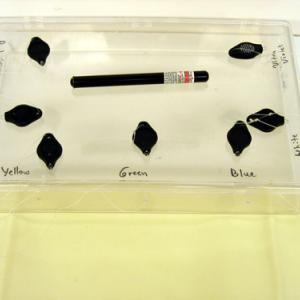College of Liberal Arts & Sciences
7A10.30 - Photoelectric Effect Demo
Set the demonstration up as shown. The filters will show at which spectral wavelengths the photocell works best. The photocell shown and the others that are available do not work exactly like the classical cells described in most of the text books because they are made of other alloys than those in the texts. Therefore the filters used for maximum effect are also in a different region of the spectrum and also have a broader bandwidth.
Another simple way to show that the shorter wavelengths contain most of the energy is to use different color LED's with some fluorescent material. The material will not be activated with the red, orange, yellow, and green lights. The blue and white lights will give some activation, but are nothing compared to the activation provided by the ultraviolet light.
The Cenco units will also show the photoelectric effect using different colored filters and an incandescent light. These are intended as a lab experiment and therefore not as large and visual as the setup described in the first paragraph.
- P. -M. Binder, "Autumn Foliage and the Photoelectric Effect", TPT, Vol. 63, #1, Jan. 2025, p. 14.
- Adolf Cortel, "Tweaking 'Simple Photoelectric Effect' Demo", TPT, Vol. 44, # 7, Oct. 2006, p. 406.
- Adolf Cortel, "Simple Photoelectric Effect", TPT, Vol. 44, # 5, May 2006, p. 310.
- Wayne P. Garver, "The Photoelectric Effect Using LEDs as Light Sources", TPT, Vol. 44, #5, May 2006, p. 272.
- Adolf Cortel, "Demonstrating the Relationship Between the Energy and Frequency of Light", TPT, Vol. 38, # 3, p. 152, March 2000.
- Dr. Hanna Goldring, "Correction Corrected", TPT, Vol. 17, # 7, Oct. 1979, p. 416.
- S.B. McKagan, W. Handley, K.K. Perkins, C.E. Wieman, "A Research-Based Curriculum for Teaching the Photoelectric Effect", AJP, Vol. 77, # 1, Jan. 2009, p. 87.
- Yaakov Kraftmakher, "Photoelectric Effect Experiment with Computer Control and Data Acquisition", AJP, Vol. 74, # 10, Oct. 2006, p. 941.
- Jearl Walker, "Simple and Vivid Demonstrations of Advanced Concepts in Physics", The Amateur Scientist, January, 1983.
- Yaakov Kraftmakher, "6.4 Photoelectric Effect", Experiments and Demonstrations in Physics, ISBN 981-256-602-3, p. 389.
- "The Photoelectric Effect", Selective Experiments in Physics, CENCO, 1962.
Disclaimer: These demonstrations are provided only for illustrative use by persons affiliated with The University of Iowa and only under the direction of a trained instructor or physicist. The University of Iowa is not responsible for demonstrations performed by those using their own equipment or who choose to use this reference material for their own purpose. The demonstrations included here are within the public domain and can be found in materials contained in libraries, bookstores, and through electronic sources. Performing all or any portion of any of these demonstrations, with or without revisions not depicted here entails inherent risks. These risks include, without limitation, bodily injury (and possibly death), including risks to health that may be temporary or permanent and that may exacerbate a pre-existing medical condition; and property loss or damage. Anyone performing any part of these demonstrations, even with revisions, knowingly and voluntarily assumes all risks associated with them.


